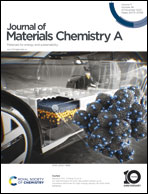ZnO–CoS heterostructure quantum dots for enhanced electrocatalytic nitrogen reduction to ammonia†
Abstract
Electrocatalytic nitrogen reduction (NRR) is considered a promising way to synthesize ammonia under environmental conditions. Due to the difficulty of achieving N2 activation in the NRR process and the competition of the hydrogen evolution reaction (HER), the development of the NRR has been seriously hindered, so it is necessary to develop efficient NRR catalysts. Herein, ZnO–CoS heterostructured quantum dots (ZnO–CoS QDs) have been used as an efficient catalyst for the NRR. As expected, formation of the heterojunction quantum dot structure can accelerate electron transport and expose more active sites. In 0.1 M Na2SO4, ZnO–CoS QDs showed a large NH3 yield of 33.03 μg h−1 mgcat.−1 and a high Faraday efficiency of 11.7% at −0.20 V; in addition, it also exhibited high electrochemical stability during the NRR test. The density functional theory (DFT) calculation that was performed revealed a Co atom near a Zn atom acting as the active site, with the catalytic performance of the catalyst improved by the formation of ZnO–CoS QDs.



 Please wait while we load your content...
Please wait while we load your content...